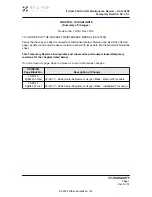
www.apcoaviation.com
22
When you are sure all is OK, you can clip in the wing and execute launch as described in paragraph 17.2.
From now on you should steer / handle the paraglider facing forward, without looking back over your shoulder. If the wing is retreating
and behind you at a low angle, do not turn around as there is a danger of falling on your back and damaging the propeller and catching
lines in the propeller, so it should be avoided.
During take-off, when you feel the tension on both risers to be equal, make sure the
wing
is overhead, open up full power and lean back
to counter the engine thrust, so that it can push you forward rather than towards the ground.
The best option is not to use the brakes, allowing the paraglider to rise as it was laid out.
If it starts to deviate from its course, pull the opposite riser and run under the centre of the wing while continuing in
the
initial direction.
If the wind suddenly drops, give a
strong
pull on the risers.
If the paraglider falls to one side or back too far to
lift
again - kill the engine, cease launch and check the conditions once again.
As the wing rises, the forces grow lighter and it should stabilize above your head without overshooting.
This is the best moment to check if it is inflated well and the lines are not tangled,
but do not stop or turn
.
Once you feel the forces on the risers decrease, run faster and let go of the risers.
See if there is already any opposition on the brakes and, if necessary, use them to correct direction or to increase lift at take-off.
Remember:
•
If the cage of your power unit is not stiff enough, the risers
will strain
during launch
and
can deform it to the extent of collision with
the propeller. Before
applying full throttle, see that the cage does not catch any lines.
•
Any brake operation (or steering input in general) should be smooth and gentle.
•
Do not try to take off until you have your wing overhead. Hitting power before that can cause dangerous oscillations.
•
Do not sit in the harness until you are sure you are flying!
•
The faster the trim setting is, the more brake input is required to take off. The HYBRID TANDEM is best with trims fully closed for
takeoff and landing
REVERSE LAUNCH (In strong wind)
Reverse launch can be executed holding in one hand both A risers and one brake, with throttle and the second brake in the other hand.
A
moderate wind
is
by far the best way.
Содержание Hybrid Tandem
Страница 1: ...www apcoaviation com 7 Chalamish St Ind Park Caesarea 3088900 ISRAEL 2020 01 27 rev 1 02 Online ...
Страница 3: ...www apcoaviation com 3 ...
Страница 30: ...www apcoaviation com 30 23 HYBRID TANDEM 18 SKETCHES ...
Страница 31: ...www apcoaviation com 31 APCO wishes you many hours of enjoyable flying Take Air ...


































